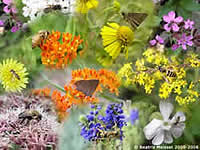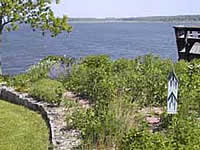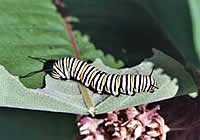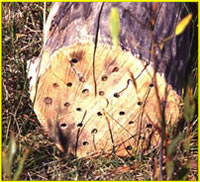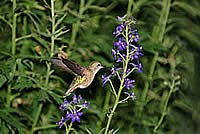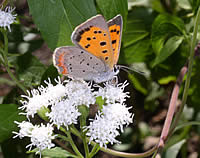USDA Forest Service Celebrating Wildflowers
|
|
|
Gardening for PollinatorsFollow these simple steps to create a pollinator-friendly landscape around your home or workplace.
Use a wide variety of plants that bloom from early spring into late fall.Help pollinators find and use them by planting in clumps, rather than single plants. Include plants native to your region. Natives are adapted to your local climate, soil and native pollinators. Do not forget that night-blooming flowers will support moths and bats. Avoid modern hybrid flowers, especially those with "doubled" flowers.Often plant breeders have unwittingly left the pollen, nectar, and fragrance out of these blossoms while creating the "perfect" blooms for us. Eliminate pesticides whenever possible.If you must use a pesticide, use the least-toxic material possible. Read labels carefully before purchasing, as many pesticides are especially dangerous for bees. Use the product properly. Spray at night when bees and other pollinators are not active. Include larval host plants in your landscape.If you want colorful butterflies, grow plants for their caterpillars. They WILL eat them, so place them where unsightly leaf damage can be tolerated. Accept that some host plants are less than ornamental if not outright weeds. A butterfly guide will help you determine the plants you need to include. Plant a butterfly garden! Create a damp salt lick for butterflies and bees.Use a dripping hose, drip irrigation line, or place your bird bath on bare soil to create a damp area. Mix a small bit of table salt (sea salt is better!) or wood ashes into the mud. Spare that limb!By leaving dead trees, or at least an occasional dead limb, you provide essential nesting sites for native bees. Make sure these are not a safety hazard for people walking below. You can also build a bee condo by drilling holes of varying diameter about 3 to 5 inches deep in a piece of scrap lumber mounted to a post or under eaves. You can add to nectar resources by providing a hummingbird feeder.To make artificial nectar, use four parts water to one part table sugar. Never use artificial sweeteners, honey, or fruit juices. Place something red on the feeder. Clean your feeder with hot soapy water at least twice a week to keep it free of mold. Butterflies need resources other than nectar.They are attracted to unsavory foodstuffs, such as moist animal droppings, urine and rotting fruits. Try putting out slices of overripe bananas, oranges and other fruits, or a sponge in a dish of lightly salted water to see which butterflies come to investigate. Sea salt provides a broader range of micronutrients than regular table salt. Learn more about pollinators.Get some guidebooks and learn to recognize the pollinators in your neighborhood. Experiment with a pair of close-focusing binoculars for butterflies, bees and hummingbirds. |
|
| NOTE: PDF format links require the Adobe Acrobat Reader to view. | |
| top | Disclaimers | FOIA | Privacy Policy | Quality of Information | Photo Credits & Use |
Location: http://www.fs.fed.us/wildflowers/pollinators/gardening.shtml
Last modified: Tuesday, 20-May-2008 15:56:17 EDT
